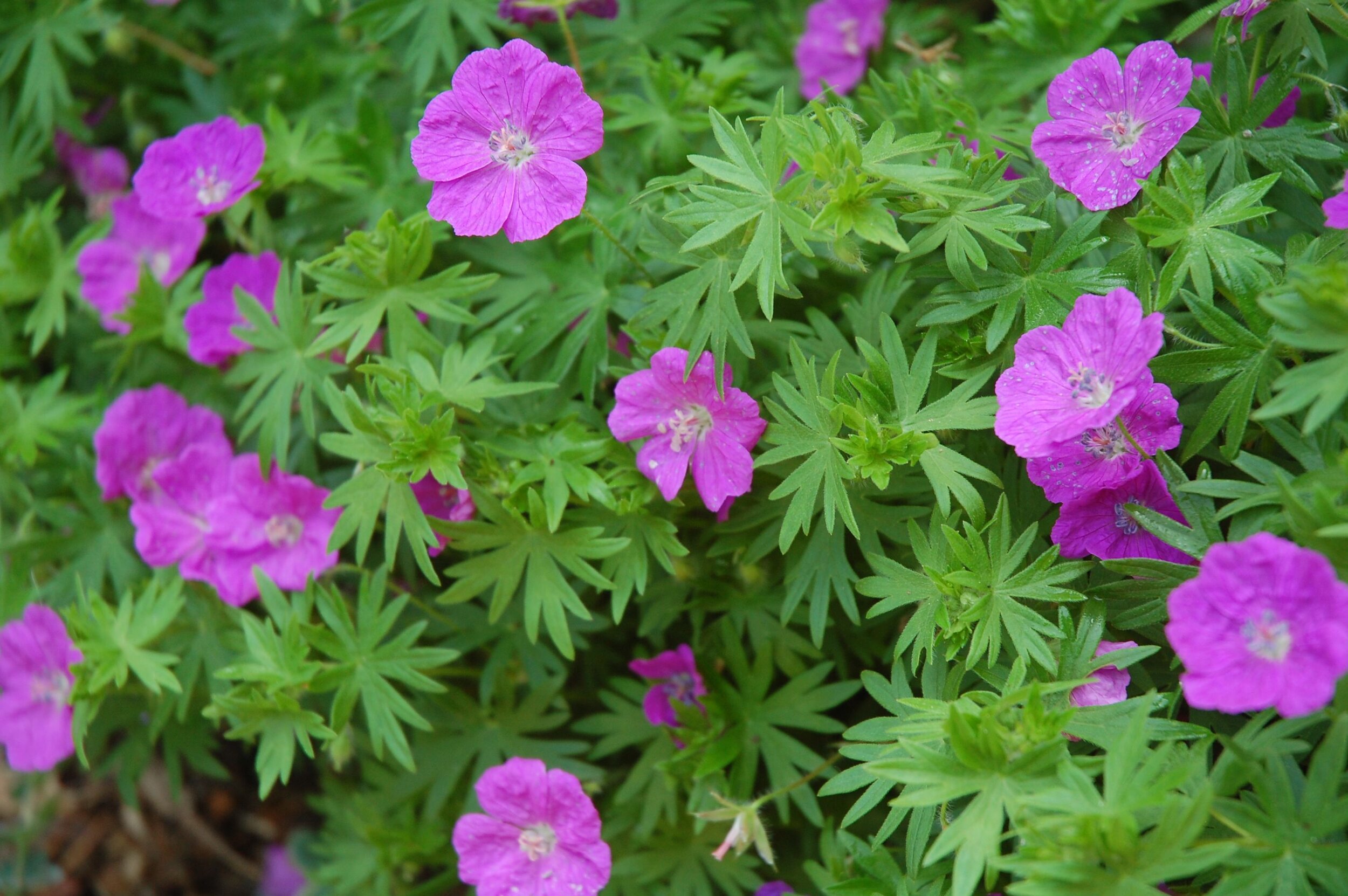Wild Geranium Geranium maculatum (genus Geranium)
Wild Geranium Geranium maculatum (genus Geranium)
Monthly Theme: I’m simply wild about WILD Geraniums!
Ahhh August, the voracious Japanese Beetles have finally stopped feasting and frolicking (making whoopie) on my plants so I can finally sit back and enjoy my gardens. The stadium mustard yellow Black-eyed Susan’s Rudbeckia hirta are in full bloom, The bees are dancing with delight around my Russian sage Perovskia atriplicifolia. The purple Hydrangea’s are bravely holding up their almost soccer ball sized flower heads. The lilac Foxglove Digitalis is showing off its trumpet-like flowers, and the roses Rosas are taking turns blooming and bringing splashes of color to my front yard!
This month’s feature plant is the Wild Geranium Geranium maculatum (genus Gernaium). In 2019, I introduced one small potted Wild Geranium plant to my yard and now I have a 3’ mounded circle. Mine are nestled next to my Lenton Rose Hellebores, Shasta Daisy’s Leucanthemum × superbum, and Bleeding Hearts Lamprocapnos spectabilis. The Wild Geranium is a native wildflower and can grow in full sun to shade. Of course, the more sun, the more flowers. It will survive in average soil, but thrive in richer soil (like the forest floors). Anyone can grow this plant – no need for a magical green thumb. You don’t even have to deadhead because the plants do not repeat bloom.
You might know this plant by one of its other common names: Cranesbill, Wood Geranium, Wood Cranesbill, Woodland Geranium, Spotted Geranium, Crane’s Bill Geranium, Alum Root, Alum Bloom, Crowfoot, Dove’s-foot, Shameface, Hardy Geranium or Old Maid's Nightcap. To keep it simple we will just call it Wild Geranium.
Wild Geranium is a woodland herbaceous perennial flower in the Geraniaceae family. It will naturalize quickly, but is not invasive. In nature, this plant is found in the woods. Therefore, the preference is for light shade to partial sunlight; however, it will grow in full sun and actually produce even more blossoms. The lobed basal leaves are attractive and the 1-1 ½” saucer-shaped flowers have five rounded petals. The flowers rise up on single stems to cover the mounds from spring to July. On the petals there are slightly darker-colored lines or veins, which function as nectar guides. I like to think of these lines as nature’s arrows pointing the direction to the nectar for the pollinators. This clump-forming plant makes a great ground cover.
They come in a variety of colors: Blue, Rose-Pink, Purple-Lavender, Red-Burgundy and White. Mine look like Crayola crayon #C154C1 Fuchsia.
Whenever I heard the word Geranium, I used to think of the annual Red Geraniums that everyone plants in their yard. However, the flowers sold in nurseries under the name of Geranium are actually Pelargoniums. Additionally, Scented Geraniums are Pelargoniums. Though, Geraniums and Pelargoniums are both in the family Geraniaceae.
After they are done blooming, the plant produces seed or fruit capsules. Each capsule consists of a long beak-like column, which resembles a crane’s head. This is why some people call them Cranesbill. Interestingly, the word Geranium comes from the Greek geranos, which means crane. This amazing plant curls upward and backward so it can spring open when ripe and forcibly eject the seeds 10-30’ from the host plant (refer to the picture below). So, it’s a self-sowing plant! If you don’t want to wait for them to self-sow, they can be propagated from divisions of the rhizomes either in the fall or early spring. Of course, you can purchase seeds, but it’s easier to just like Mother Nature do her thing.
Smarty Plants Fun Facts
Wild Gernanum belong to the family Geraniaceae
Full sun to shade (anything goes!)
Can grow 12-18” tall
Blooms April to July
Attracts butterflies, honeybees, and bumblebees; resistant to insects, diseases, landscape fires, deer, and rabbits.
Soil pH: Acid (<6.0) Neutral (6.0-8.0)
The More You Grow
Medicinal Purposes
Wild Geranium is a natural astringent like White Oak Bark because of the high level of tannins. Some health issues that respond well to astringents are wounds, hemorrhoids, diarrhea, kidney issues, and irritable bowel. Chinese medicine uses astringents to stabilize and blind. Further it can be used as an antiseptic for external discharges (pus) or inflammations. Infusions can be made from any part of the plant, but the rhizome has the most potent healing properties.
Native Americans used Wild Geranium roots to treat diarrhea, open sores, and other health issues. In the Middle Ages, Swiss physicians believed that the Geranium was a cardio-tonic and could be used to combat depression. In Ireland, the plant was used for diabetes. In Scotland, it was used to stop the bleeding after the removal of a tooth. In Wales, it was used to treat gout. In Chile, it used to treat fever, shock, and cataract. In Japan, it was used to treat diarrhea, liver, and hematological disorders. In India, it was used in a paste form to treat insect bites and ulcers. Like Doctors Without Borders, this mighty plant has been around the world healing people!
Symbolism, Myths & Magic
Wild Geraniums are rich in flower symbolism. They are associated with love, peace, joy, health, fertility, and spirituality. However, during Victorian era, Geraniums were assigned negative connotations such as envy and deceit, but there were a lot of messed up thought processes during the period of time!
The witch doctor would use Wild Geranium tea as an effective counter to love spells. A piece of the root can be carried to attract prosperity and happiness. It was used in spells to boost conception, encourage a successful pregnancy and childbirth.
From Islamic to Christian, Geraniums symbolism is associated to gods and saints. In Egypt, it was a symbol of prosperity. In China, a symbol of immortality. Christian missionaries often renamed native plants in honor of Christian saints or martyrs. The origin of the name Geranium robertianum is attributed to Saint Robert. In the United Kingdom, Geranium robertianum has been considered an ill-omen death plant, and children were told not to pick the flowers.
According to legend, the origin of the Geranium is related to the life of Prophet Mohammed. It was said that after washing his shirt, he threw it on a plant to dry. Astonishingly, upon contact, the plant turned into a Geranium flower. Walla!
Last story, in Scandinavian mythology, the Geranium was dedicated to Odin, the god of wisdom, poetry, and war. Unsurprisingly, the Geranium was known as Odin’s Favor. I could go on and on, but I think you and I need to get back outside and enjoy our gardens.
Happy gardening fellow yogis!


